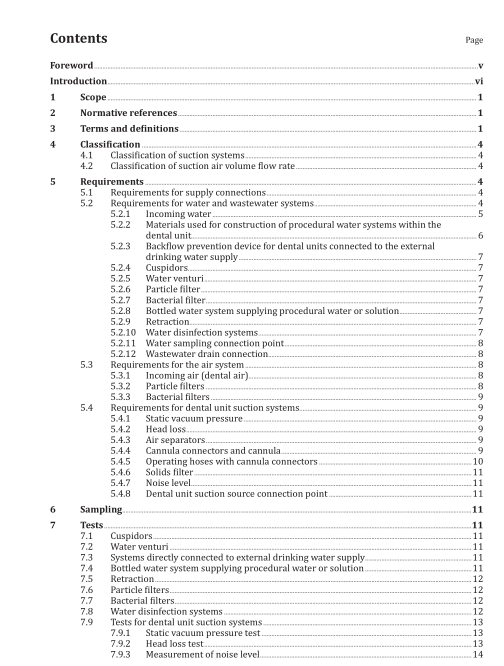ISO 7494-2:2015 pdf download.Dentistry — Dental units — Part 2: Air, water, suction and wastewater systems
4Classification
4.1Classification of suction systems
According to ISO 10637:1999, suction systems are classified to the type of suction as follows:
a) dry system;
b) semi-dry system;
c) wet system.
4.2Classification of suction air volume flow rate
According to ISO 10637:1999, suction systems are classified to the type of air volume flow rate as follows:
a) type 1: high-volume suction system, suction system with an air intake of more than 250 Nl/min 1) at the suction cannula connector;
b) type 2: medium-volume suction system, suction system with an air intake between 90 Nl/min and 250 Nl/min 1) at the suction cannula connector.
5 Requirements
5.1 Requirements for supply connections
The manufacturer’s technical description shall include the configuration of the supply connections for the dental unit. The specified configuration of the supply connections shall lie within a maximum area of 180 mm × 220 mm.
The manufacturer’s technical description shall include detailed information of the position and the dimensions of supply connections (see keys 1 to 5 in Figure 1) for the dental unit in the dental treatment centre.
In the dental treatment centre, often a core hole in the floor with a diameter of 160 mm is used. Therefore,it is recommended to place the supply connections within this diameter.
An example of the configuration and the connection points is given in Figure 1.
Dimensions for the connections for electricity and compressed air areas (see keys 4 and 5 in Figure 1) are given as maximum values.
Dimensions for plumbing holes (see keys 1, 2, and 3 in Figure 1) are given as minimum values. The diameters specify the free space required for tubes and hoses.
The holes without dimensions can be positioned anywhere inside the connection area.
Gas tubing, if required, shall not be located inside the areas specified in Figure 1.
The location of other utility connections which are not indicated shall be specified by the manufacturer.
This test is in accordance with 7.12.
5.2 Requirements for water and wastewater systems
NOTE A schematic diagram of possible water and wastewater systems is given as example in Figure A.1.
5.2.1 Incoming water
The manufacturer’s instructions for use and technical description shall specify the requirements for the incoming water to be supplied to the dental unit, including the following parameters.
The following values are recommendations:
a) water pressure limits (2 bar to 6 bar);
b) water flow rate limit (greater than 5 l/min);
c) water hardness limit [less than 2,14 mmol/l (<12 °dH)];
d) pH limits (6,5 to 8,5);
e) maximum particle size (<100 µm);
f) conformance to local drinking water regulations.
This test is in accordance with 7.11.
5.2.2 Materials used for construction of procedural water systems within the dental unit The dental unit shall be designed and constructed in such a way that the materials which come into contact with the procedural water or solutions or that are likely to come into contact with them do not cause an unacceptable risk to the quality of the procedural water or solution.
The materials used within the water path shall be documented by the manufacturer. The materials used shall be evaluated by risk analysis to ensure that they do not cause an unacceptable risk to the quality
of procedural water or solution.
Manufacturers shall document this risk analysis in accordance with ISO 14971.
5.2.3 Dental units directly connected to the external drinking water supply system and using this water as procedural water shall have a backflow prevention device at the connection point with the water supply or an air gap of not less than 20 mm.
This test is in accordance with 7.3.
5.2.4 Cuspidors
The point where the cuspidor rinse water is dispensed shall be at least 20 mm above the spill-over level of the cuspidor.
This test is in accordance with 7.1.ISO 7494-2 pdf download.ISO 7494-2 pdf download
